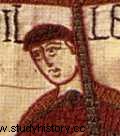Guillaume is the illegitimate son of the Duke of Normandy Robert the Magnificent (which will earn him the nickname of William the Bastard ), he succeeded him at the age of eight. His minority was marked by a revolt of the barons of Lower Normandy, which he only triumphed in 1047 with the help of the




